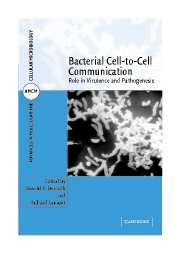Book contents
- Frontmatter
- Contents
- List of Contributors
- Preface
- 1 Quorum sensing and regulation of Pseudomonas aeruginosa infections
- 2 The Pseudomonas aeruginosa quinolone signal
- 3 Quorum-sensing-mediated regulation of plant–bacteria interactions and Agrobacterium tumefaciens virulence
- 4 Jamming bacterial communications: new strategies to combat bacterial infections and the development of biofilms
- 5 Quorum-sensing-mediated regulation of biofilm growth and virulence of Vibrio cholerae
- 6 LuxS in cellular metabolism and cell-to-cell signaling
- 7 LuxS-dependent regulation of Escherichia coli virulence
- 8 Quorum sensing and cell-to-cell communication in the dental biofilm
- 9 Quorum-sensing-dependent regulation of staphylococcal virulence and biofilm development
- 10 Cell-density-dependent regulation of streptococcal competence
- 11 Signaling by a cell-surface-associated signal during fruiting-body morphogenesis in Myxococcus xanthus
- Index
- Plate Section
Preface
Published online by Cambridge University Press: 08 August 2009
- Frontmatter
- Contents
- List of Contributors
- Preface
- 1 Quorum sensing and regulation of Pseudomonas aeruginosa infections
- 2 The Pseudomonas aeruginosa quinolone signal
- 3 Quorum-sensing-mediated regulation of plant–bacteria interactions and Agrobacterium tumefaciens virulence
- 4 Jamming bacterial communications: new strategies to combat bacterial infections and the development of biofilms
- 5 Quorum-sensing-mediated regulation of biofilm growth and virulence of Vibrio cholerae
- 6 LuxS in cellular metabolism and cell-to-cell signaling
- 7 LuxS-dependent regulation of Escherichia coli virulence
- 8 Quorum sensing and cell-to-cell communication in the dental biofilm
- 9 Quorum-sensing-dependent regulation of staphylococcal virulence and biofilm development
- 10 Cell-density-dependent regulation of streptococcal competence
- 11 Signaling by a cell-surface-associated signal during fruiting-body morphogenesis in Myxococcus xanthus
- Index
- Plate Section
Summary
It is now well established that a number of bacteria communicate through diffusible signals that may induce and/or regulate a coordinated response by the individual organisms that make up a given population or biofilm. For many of these organisms, it has been suggested that intercellular signaling functions to report population density or to coordinate a response from all cells in a microbial community. Therefore, cell-to-cell communication has been referred to as auto-induction or quorum sensing. The response of bacteria to quorum sensing signals is quite varied and includes, for example, the induction of bioluminescence, the regulation of virulence gene expression, the formation of biofilms, or the induction of horizontal transfer of genetic material. It is also becoming increasingly apparent that some bacteria may communicate via contact-dependent signaling mechanisms, and that the response to direct cell-to-cell contact influences complex behaviors that may contribute to multicellular development or the adaptation to growth in complex biofilms. In the past five to ten years, increased interest and research in the mechanisms of bacterial cell-to-cell communication has revealed surprising complexity both in the signaling processes themselves and in the breadth of the response of recipient cells to the signal molecules. For example, a variety of chemical species, e.g. acyl-homoserine lactones, oligopeptides, furan derivatives (i.e. AI-2), quinolones, butyrolactones, and unsaturated fatty acids are known or have been suggested to function as diffusible signals. Furthermore, some organisms, most notably Pseudomonas aeruginosa and species of Vibrio, have been shown to produce and respond to multiple diffusible signal molecules.
- Type
- Chapter
- Information
- Bacterial Cell-to-Cell CommunicationRole in Virulence and Pathogenesis, pp. xiii - xviPublisher: Cambridge University PressPrint publication year: 2006



